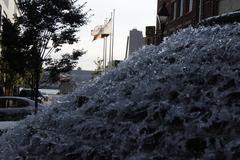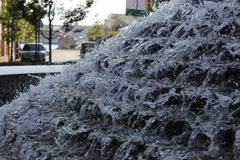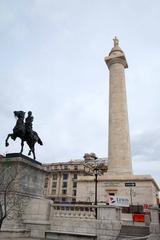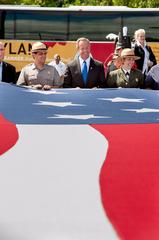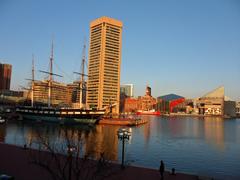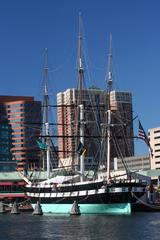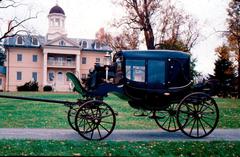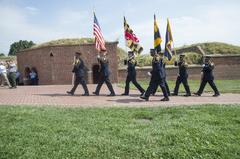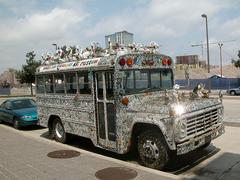
Comprehensive Guide to Visiting National Katyn Memorial Park, Baltimore, United States
Date: 01/08/2024
Introduction
The National Katyn Memorial Park in Baltimore, Maryland, is a deeply significant historical site that honors the victims of the Katyn Massacre of 1940. This tragic event saw the execution of approximately 22,000 Polish military officers, intellectuals, and civilians by the Soviet Union, leaving an indelible mark on Polish history. The memorial stands as a testament to the resilience and enduring spirit of the Polish people, providing a space for remembrance and education about these wartime atrocities. The inception of the National Katyn Memorial can be traced back to the efforts of Clement Knefel, a major in the U.S. Army, who was moved by the need to commemorate the victims after learning about the massacre during the Nuremberg War Crimes Trials (National Katyn Memorial Foundation). Over the years, the memorial has evolved, thanks to the dedicated efforts of the Katyn Memorial Committee of Baltimore and the financial support from various organizations, including the Associated Jewish Charities and the Polish Embassy (National Katyn Memorial Foundation). Today, the memorial not only serves as a poignant reminder of past atrocities but also as an educational site that fosters a deeper understanding of the historical relations between Poland and the Soviet Union, as well as the broader implications of war crimes during World War II.
Table of Contents
- Introduction
- History of the National Katyn Memorial
- Origins and Early Efforts
- Formation of the Katyn Memorial Committee
- Fundraising and Support
- Site Dedication and Monument Creation
- Organizational Changes and Continued Efforts
- Establishment of the National Katyn Memorial Foundation
- Interpretive Signage and Educational Efforts
- Legacy and Ongoing Commemoration
- Visitor Information
- FAQ
- Annual Remembrance Events
- Conclusion
History of the National Katyn Memorial
Origins and Early Efforts
The inception of the National Katyn Memorial can be traced back to the efforts of Clement Knefel, a major in the U.S. Army who was stationed in Germany during the Nuremberg War Crimes Trials. It was during this period that Knefel learned about the Katyn Forest Massacre, a tragic event where thousands of Polish officers were executed by the Soviet NKVD in 1940. Moved by the need to commemorate the victims, Knefel envisioned a memorial plaque in Patterson Park, Baltimore. His initial fundraising efforts were modest, involving the sale of soft drinks and sandwiches at local festivals, and small donations from veterans’ organizations. Over a decade, he managed to raise $1,600 (National Katyn Memorial Foundation).
Formation of the Katyn Memorial Committee
In 1989, Knefel sought the assistance of the Maryland Division of the Polish American Congress to honor the Katyn victims and all mistreated prisoners-of-war. This collaboration led to the formation of the Katyn Memorial Committee of Baltimore. The committee’s first meetings were held at the Polish veterans’ hall on Fleet Street, with key members including Clement Knefel (Chairman), Melvin Laszczynski, Wojslaw Milan-Kamski (1st Vice-Chairman), and Alfred Wisniewski (Fundraising Chairman) (National Katyn Memorial Foundation).
Fundraising and Support
The committee’s fundraising efforts continued, receiving support from various sources. A significant boost came from Andrzej Pitynski, a renowned Polish-American sculptor, who was recommended by the Polish Embassy to design the memorial. The project also garnered substantial financial contributions from the Associated Jewish Charities, facilitated by Senator Barbara Mikulski, the Honorary Chair of the Committee. Baltimore Mayor Kurt Schmoke pledged his support and helped secure the monument site in the Inner Harbor East area (National Katyn Memorial Foundation).
Site Dedication and Monument Creation
The site dedication ceremony took place on September 29, 1996, with Monsignor Zdzislaw Peszkowski, a Katyn Massacre survivor, bringing an urn of earth from the mass graves in the Katyn Forest. The monument’s creation was overseen by committee members who made trips to the GZUT foundry in Gliwice, Poland. Despite delays due to storms and labor issues, the monument was finally delivered and dedicated on November 19, 2000, at Katyn Circle, following a Mass at Holy Rosary Church (National Katyn Memorial Foundation).
Organizational Changes and Continued Efforts
In 1994, the group incorporated in the State of Maryland as the National Katyn Memorial Committee and secured 501(c)3 status with the IRS. Clement Knefel resigned due to ill health and was succeeded by Wojslaw Milan-Kamski, followed by Alfred Wisniewski. The committee sought a grant from the State of Maryland during the 1997 General Assembly session, with Senator Perry Sfikas introducing the bill. The grant was approved with the support of Lt. Governor Kathleen Kennedy Townsend and Governor Parris Glendening, and Mayor Schmoke provided the final financial guarantee (National Katyn Memorial Foundation).
Establishment of the National Katyn Memorial Foundation
In 2001, the committee reorganized itself as the National Katyn Memorial Foundation. The foundation’s activities expanded to include annual Remembrance Masses in April and public ceremonies at the monument. The foundation also engaged in various projects, such as distributing descriptive flyers and colorful postcards, and transferring its complete archives to the University of Baltimore Langsdale Library Special Collections’ Archives of Maryland Polonia. Additionally, the foundation supported Monsignor Peszkowski in distributing copies of his book, “Katyń w Dokumentach Kongresu USA,” to every school in Poland (National Katyn Memorial Foundation).
Interpretive Signage and Educational Efforts
One of the foundation’s significant undertakings was the creation of permanent interpretive signage displays at the monument site. These displays provide visitors with detailed explanations of the symbols on the monument, enhancing their understanding of the Katyn Massacre and its historical context. The foundation continues to promote and preserve the story of the Katyn Massacre, ensuring that future generations learn from this tragic event (National Katyn Memorial Foundation).
Legacy and Ongoing Commemoration
The National Katyn Memorial stands as a poignant reminder of the atrocities committed during the Katyn Massacre and serves as a symbol of remembrance for all mistreated prisoners of war. The foundation’s ongoing efforts to educate the public and commemorate the victims underscore the importance of remembering history to prevent such tragedies from occurring again. The memorial’s dedication to the phrase “Nigdy Więcej!” – Never Again! – encapsulates its mission to honor the past while advocating for a more just and peaceful future (National Katyn Memorial Foundation).
Visitor Information
Visiting Hours and Tickets
The National Katyn Memorial is open to the public 24/7 and there is no admission fee. Visitors are encouraged to visit during daylight hours to fully appreciate the interpretive signage and the monument’s intricate details.
Travel Tips and Nearby Attractions
Located at Katyn Circle in Inner Harbor East, Baltimore, the memorial is easily accessible by car and public transportation. Nearby attractions include the National Aquarium, the American Visionary Art Museum, and the historic Fell’s Point district, making it a perfect addition to any Baltimore itinerary.
Accessibility
The monument site is wheelchair accessible, and there are benches nearby for those who need to rest. Ample parking is available in the vicinity.
Special Events and Tours
The National Katyn Memorial Foundation organizes annual Remembrance Masses in April and other public ceremonies. While there are no regular guided tours, groups can arrange special tours by contacting the foundation directly.
Photographic Spots
The monument, with its dramatic sculptures and serene surroundings, offers numerous photo opportunities. Early morning and late afternoon light provide the best conditions for photography.
FAQ
Q: What are the visiting hours for the National Katyn Memorial?
A: The National Katyn Memorial is open 24/7.
Q: Is there an admission fee to visit the memorial?
A: No, visiting the memorial is free of charge.
Q: Can I arrange a guided tour?
A: Yes, you can arrange special tours by contacting the National Katyn Memorial Foundation.
Q: Is the memorial wheelchair accessible?
A: Yes, the site is wheelchair accessible.
Annual Remembrance Events
Overview of Annual Remembrance Events
The annual remembrance events at National Katyn Memorial Park are meticulously organized to ensure a respectful and educational experience for attendees. The day typically begins with a bilingual Mass at Holy Rosary Parish, a historic Polish church located in downtown Baltimore. This Mass is a solemn occasion, often attended by dignitaries, including the Polish Ambassador or their representative, as well as local, regional, and national Polish organizations (katynbaltimore.org).
Following the Mass, participants usually gather for a communal breakfast featuring coffee and doughnuts, fostering a sense of community and shared purpose. This meal provides an opportunity for attendees to discuss the significance of the Katyn Massacre and the importance of remembering such events to prevent future atrocities (TFP).
The Memorial Ceremony
The heart of the remembrance events is the ceremony held at the National Katyn Memorial itself, located at the intersection of President and Aliceanna Streets in Baltimore’s Harbor East district. The monument, a 56-foot-tall bronze statue, is the tallest in Baltimore and features a large gold-colored flame symbolizing rebirth and transformation. Amid the flames stand statues of significant figures from Polish history, such as Boleslaw Chrobry, the first crowned king of Poland, and King Jan Sobieski, who led his winged hussars to defeat the Turks and lift the siege of Vienna (dctravelmag.com).
During the ceremony, speeches are delivered by various dignitaries and representatives of Polish organizations. These speeches often highlight the historical context of the Katyn Massacre, its impact on Polish society, and the ongoing importance of remembering such events. The ceremony also includes the laying of wreaths at the base of the monument, a moment of silence, and the playing of the Polish national anthem (katynbaltimore.org).
Educational and Cultural Activities
In addition to the formal ceremonies, the annual remembrance events often feature educational and cultural activities designed to deepen the public’s understanding of the Katyn Massacre and Polish history. These activities may include:
-
Exhibits and Displays: Informational displays are set up at community events and at the Polish National Alliance, providing historical context and personal stories related to the Katyn Massacre. These exhibits often include photographs, documents, and artifacts from the period (katynbaltimore.org).
-
Lectures and Discussions: Experts in Polish history and representatives from the National Katyn Memorial Foundation frequently give lectures and lead discussions on the significance of the Katyn Massacre. These sessions aim to educate attendees about the broader historical and political implications of the massacre (TFP).
-
Cultural Performances: The events may also include performances of traditional Polish music and dance, providing a cultural context and celebrating Polish heritage. These performances serve to remind attendees of the rich cultural history that the victims of the Katyn Massacre were a part of (katynbaltimore.org).
Community Involvement and Support
The success of the annual remembrance events is largely due to the active involvement and support of the Polish-American community in Baltimore. The National Katyn Memorial Foundation plays a crucial role in organizing these events, ensuring that they are well-publicized and attended. The foundation also works to secure funding and donations to support the maintenance of the memorial and the continuation of these important events (katynbaltimore.org).
Local businesses and organizations often contribute to the events by providing venues, refreshments, and logistical support. For example, in cases of inclement weather, the Polish National Alliance has hosted the ceremony indoors, ensuring that the remembrance can proceed without interruption (katynbaltimore.org).
Impact and Significance
The annual remembrance events at the National Katyn Memorial Park serve multiple important functions. They honor the memory of the victims of the Katyn Massacre, ensuring that their sacrifices are not forgotten. They also educate the public about this dark chapter in history, fostering a deeper understanding of the impact of totalitarian regimes and the importance of vigilance against such atrocities.
Moreover, these events strengthen the bonds within the Polish-American community and between the community and the broader public. By coming together to remember and reflect, attendees reaffirm their commitment to preserving the memory of the past and working towards a future where such tragedies are never repeated (TFP).
Conclusion
The National Katyn Memorial Park in Baltimore is more than just a historical site; it is a powerful symbol of remembrance, resilience, and the enduring spirit of the Polish people. The annual remembrance events, educational activities, and the ongoing efforts of the National Katyn Memorial Foundation ensure that the memory of the Katyn Massacre victims is preserved for future generations. By visiting the memorial, individuals not only pay tribute to those who suffered but also gain insight into the broader historical and political contexts of the massacre. As a significant part of Baltimore’s cultural and historical landscape, the National Katyn Memorial Park continues to educate and inspire, promoting a message of vigilance and the importance of remembering history to prevent future atrocities (National Katyn Memorial Foundation; TFP). For those looking to explore Baltimore’s rich historical tapestry, a visit to the National Katyn Memorial Park is an essential and meaningful experience.
References
- National Katyn Memorial Foundation. (n.d.). Retrieved from National Katyn Memorial Foundation
- TFP. (n.d.). They shall not be forgotten - Remembering the victims of Katyn. Retrieved from TFP

